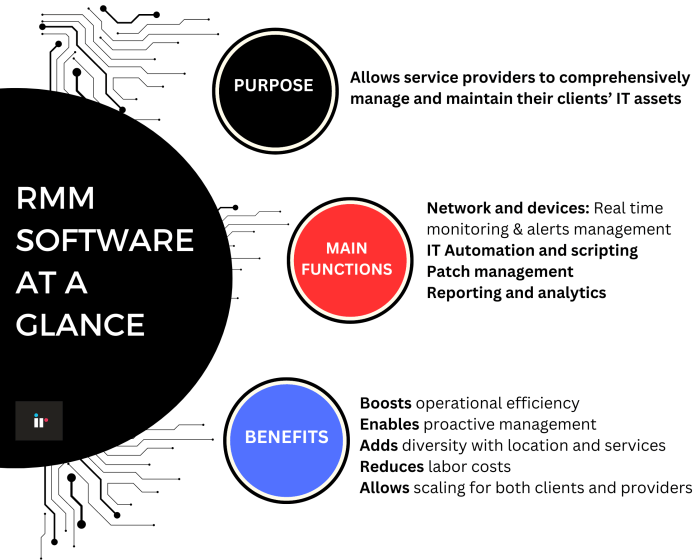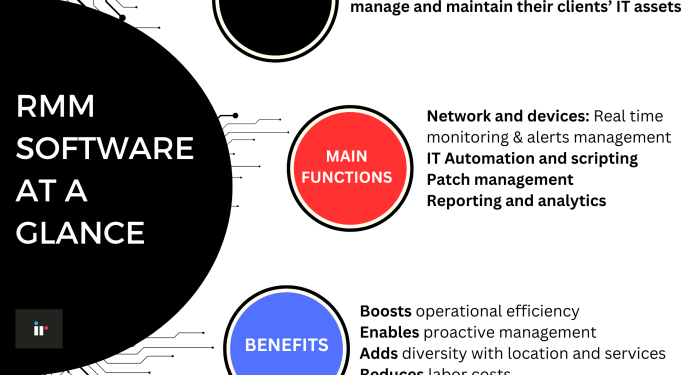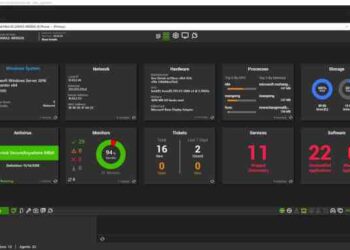Popular RMM systems for MSPs set the stage for this enthralling narrative, offering readers a glimpse into a story that is rich in detail and brimming with originality from the outset.
Overview of Popular RMM Systems for MSPs
Managed Service Providers (MSPs) rely on Remote Monitoring and Management (RMM) systems to efficiently monitor and manage their clients' IT infrastructure. Here are some of the most widely used RMM systems in the industry:
List of Popular RMM Systems:
- ConnectWise Automate
- Kaseya VSA
- LabTech (Now ConnectWise Automate)
- SolarWinds N-central
- Atera
Key Features of Popular RMM Systems:
- Remote monitoring and management of client endpoints
- Automated patch management and software updates
- Network monitoring and alerting
- Integration with Professional Services Automation (PSA) tools
- Customizable scripting and automation capabilities
Enhancing Efficiency and Productivity:
These RMM systems streamline MSP operations by providing real-time visibility into client networks, automating routine tasks, and facilitating proactive maintenance. By centralizing monitoring and management tasks, MSPs can respond to issues faster and minimize downtime for their clients.
Choosing the Right RMM System:
It is crucial for MSPs to carefully evaluate their specific needs and requirements when selecting an RMM system. Factors to consider include scalability, ease of use, integration capabilities with existing tools, and overall cost. The right RMM system can significantly impact the efficiency and profitability of an MSP's business operations.
Key Features and Functionalities of Popular RMM Systems
Remote Monitoring and Management (RMM) systems are essential tools for Managed Service Providers (MSPs) to efficiently monitor and manage their clients' IT infrastructure. Let's explore the key features and functionalities offered by popular RMM systems that help MSPs streamline their operations and provide top-notch services to their clients.
Remote Monitoring
- Real-time monitoring of servers, workstations, and network devices.
- Alerts and notifications for potential issues or failures.
- Performance monitoring to ensure optimal system health and uptime.
Patch Management
- Automated patch deployment for operating systems and software applications.
- Scheduling of patch updates during non-business hours to minimize disruptions.
- Compliance checks to ensure all systems are up to date and secure.
Automation
- Automated workflows for routine tasks like software installations and updates.
- Scripting capabilities to customize automation processes based on specific needs.
- Integration with third-party tools and services for seamless automation across systems.
Security Capabilities
- Vulnerability scanning to identify potential security risks and threats.
- Endpoint protection against malware, ransomware, and other cyber threats.
- Encryption and data protection features to safeguard sensitive information.
Benefits for MSPs
- Improved efficiency and reduced manual intervention through automation.
- Proactive monitoring and maintenance to prevent downtime and issues.
- Enhanced security measures to protect client data and ensure compliance.
Integration Capabilities of RMM Systems
Integration capabilities play a crucial role in the efficiency and effectiveness of Managed Service Providers (MSPs) utilizing Remote Monitoring and Management (RMM) systems. Seamless integration with other tools and platforms enables MSPs to streamline their workflows, improve automation, and enhance overall service delivery
Common Integrations Supported by Popular RMM Systems
- Integration with Professional Services Automation (PSA) tools: Popular RMM systems often offer integrations with PSA platforms such as ConnectWise Manage, Autotask, and Kaseya BMS. This integration allows for a seamless flow of data between RMM and PSA systems, eliminating manual data entry and ensuring accurate information across both platforms.
- Integration with Ticketing Solutions: Many RMM systems support integrations with ticketing solutions like Zendesk, ServiceNow, and Freshdesk. This integration enables automated ticket creation based on monitored alerts, real-time updates on ticket status within the RMM dashboard, and improved incident management processes.
- Integration with Remote Access Tools: Popular RMM systems often integrate with remote access tools like TeamViewer, Splashtop, and AnyDesk. This integration allows MSP technicians to quickly access and troubleshoot endpoints remotely, reducing response times and improving client satisfaction.
Advantages of Integrating RMM Systems with PSA and Ticketing Solutions
- Enhanced Efficiency: Integration between RMM systems and PSA/ticketing solutions eliminates duplicate data entry, reduces errors, and streamlines processes, saving time and resources for MSPs.
- Improved Visibility: Integrations provide real-time visibility into client information, alerts, tickets, and service requests, enabling MSPs to make informed decisions and prioritize tasks effectively.
- Automated Workflows: Integrating RMM systems with PSA and ticketing solutions automates various tasks such as ticket creation, assignment, and resolution, leading to faster response times and improved service delivery.
Examples of Streamlining MSP Operations and Enhancing Service Delivery through Integrations
- Automatic Ticket Creation: When a monitored alert triggers an incident, the RMM system can automatically create a ticket in the integrated PSA platform, assigning it to the appropriate technician for resolution.
- Real-time Updates: Technicians can receive real-time updates on ticket status and client information directly within the RMM dashboard, ensuring they have the latest information to address issues promptly.
- Proactive Maintenance: Integrating RMM systems with remote access tools allows MSPs to proactively perform maintenance tasks on endpoints, preventing potential issues before they impact clients.
Customization and Scalability Options
Customization and scalability are crucial factors for MSPs when choosing an RMM system. The ability to tailor the tool to meet specific client needs and seamlessly expand as the business grows is essential for long-term success.
Flexibility and Scalability Offered by Leading RMM Systems
Leading RMM systems provide a wide range of customization options, allowing MSPs to adapt the tool to their unique requirements. These systems also offer scalability features that enable MSPs to easily increase their capacity and accommodate a growing client base.
- Customizable dashboards and reporting tools
- Flexible automation workflows
- Scalable infrastructure to handle increasing workloads
- Integration capabilities with other tools and platforms
Importance of Customization Features for MSPs
Customization features enable MSPs to tailor the RMM system to meet the specific needs of each client. This level of personalization helps build stronger client relationships and increases satisfaction by delivering services that align closely with the client's requirements.
Contribution of Customization and Scalability to Business Growth
By leveraging customization and scalability options, MSPs can not only meet current client needs but also position themselves for future growth. The ability to adapt the RMM system to changing business requirements and scale operations efficiently allows MSPs to expand their service offerings and client base.
Examples of Successful Customization and Scaling Strategies
Many MSPs have successfully implemented customization and scaling strategies using popular RMM systems. For instance, some have created tailored monitoring templates for specific industries, while others have automated routine tasks to improve efficiency and scalability. These strategies have enabled MSPs to deliver high-quality services while driving business growth and profitability.
Last Recap

In conclusion, Popular RMM systems for MSPs open up a world of possibilities for managed service providers, revolutionizing the way they monitor, manage, and scale their operations.
FAQ Guide
What are the most widely used RMM systems in the MSP industry?
The most widely used RMM systems in the MSP industry include ConnectWise Automate, SolarWinds RMM, and Kaseya VSA.
How do RMM systems help MSPs with remote monitoring?
RMM systems enable MSPs to remotely monitor client endpoints, servers, and networks, allowing for proactive issue detection and resolution.
Why is seamless integration with other tools important for RMM systems?
Seamless integration with other tools allows MSPs to streamline their operations, improve efficiency, and deliver better services to clients.





![Top 10 RMM Solutions [2024] | NinjaOne](https://ecommerce.mardinata.com/wp-content/uploads/2025/10/Best-RMM-Software-and-Tools-1-120x86.jpg)




